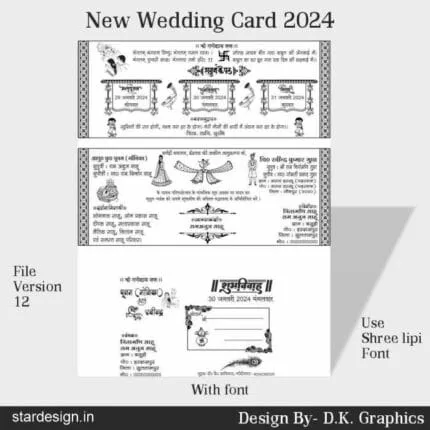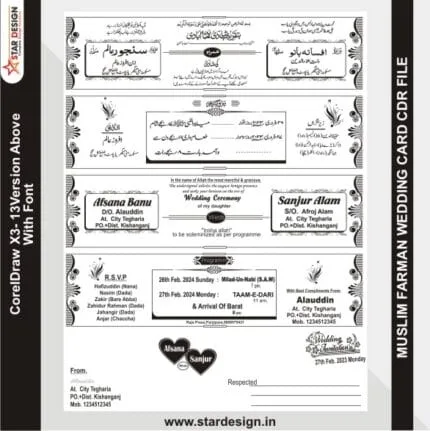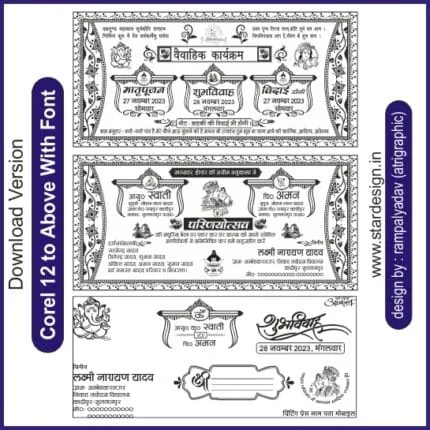New Fancy Shadi Card For Hindu Cdr File
Introduction to Shadi Cards
Shadi cards, also known as wedding invitations, hold a significant place in Hindu weddings, serving as more than just a means of communication; they are a cultural emblem that reflects the grace and grandeur of the occasion. Traditionally, these intricately designed cards symbolize the union of two families, inviting friends and relatives to partake in the celebratory events. The cultural relevance of shadi cards is profound, as they not only convey essential details about the wedding but also encapsulate the values, traditions, and aesthetics of the families involved.
In the context of Hindu weddings, a shadi card often features symbolic elements such as auspicious colors, motifs like peacocks, and divine symbols, which hold deep significance in the culture. Emerging trends in wedding stationery have introduced modern designs that maintain this cultural ethos while embracing contemporary aesthetics. Modern shadi cards often employ minimalistic designs, elegant typography, and thematic color palettes, showcasing a blend of tradition and innovation. This shift highlights an evolution in preferences, where couples seek to express their individuality while honoring their heritage.
The visual appeal of shadi cards is undeniable; they serve as a tangible representation of the celebratory spirit. The choice of paper, printing technique, and embellishments contribute to their overall allure. Emotionally, a beautifully crafted card evokes excitement and anticipation for the significant life event ahead. Families eagerly distribute these invitations, carrying a sense of pride as they extend invites to their loved ones. In contemporary settings, the rise of digital shadi cards has also transformed the way invitations are shared, reflecting how tradition seamlessly adapts to modern lifestyles.
Understanding CDR Files
CorelDRAW’s CDR files serve as a quintessential format widely utilized in graphic design, particularly for creating intricate and customized shadi cards, a significant aspect of Hindu matrimonial ceremonies. CDR, which stands for CorelDRAW, is a vector graphic file format that permits designers to create scalable images that retain their quality, regardless of size variations. This scalability ensures that designs remain sharp and clear when printed, which is crucial for high-resolution outputs needed for ceremonial invitations.
The principal advantage of utilizing CDR files in graphic design lies in their capability to manage complex graphics and layouts efficiently. Unlike raster formats such as JPEG or PNG, which can lose clarity when enlarged, CDR files consist of vector images that are defined by mathematical equations, ensuring crisp and detailed visuals. This quality makes them particularly advantageous for shadi card designs, where ornamental details and artistic expressions are paramount. Additionally, CDR files support a broad range of colors, allowing designers to craft visually striking and vibrant designs that appeal to various audience preferences.
Moreover, CDR files provide compatibility with numerous graphic design tools and can integrate smoothly with both web and print mediums. This versatility allows designers to manipulate images easily, optimizing them for numerous applications, from digital invitations to printed cards. Furthermore, the intuitive interface of CorelDRAW makes it easier for designers to experiment with various features, enhancing creativity and efficiency during the design process. Consequently, the use of CDR files has emerged as a preferred choice within the design community for crafting personalized and elegant shadi cards. Overall, the technical benefits and aesthetic possibilities afforded by CDR files highlight their integral role in contemporary graphic design practices.
Trends in Fancy Shadi Card Designs
The world of shadi cards has experienced a notable transformation over the past few years, evolving to meet the tastes and preferences of contemporary couples. Modern shadi card designs showcase an array of themes that reflect the couple’s unique personalities and cultural backgrounds. From minimalistic elegance to elaborate artistic expressions, the choice of design can profoundly influence the overall tone of the wedding celebration.
One of the prevailing trends is the use of vibrant color schemes that move beyond traditional palettes. Couples today are opting for bold hues like emerald green, royal blue, and deep burgundy, often complemented by metallic accents such as gold and silver. These rich color combinations not only add a sophisticated touch but also engage recipients’ attention right from the moment they receive the invitation. Pastel colors, particularly soft pinks and lavenders, remain popular for those who prefer a more subdued aesthetic, creating an inviting aura that reflects modern sensibilities.
Furthermore, the incorporation of theme-based designs plays a significant role in the contemporary shadi card landscape. Many couples are choosing to weave their love story into the card by utilizing personalized themes, such as vintage-inspired motifs, rustic charm, or even incorporating elements from destination weddings. This trend allows couples to express their creativity while making their invitations memorable for guests.
Technology has also played a pivotal role in this evolution. The rise of digital invitations has provided couples with the ability to create dynamic, interactive designs that utilize multimedia elements. Videos, animations, and even personalized soundtracks can now be integrated into digital shadi cards, enhancing their appeal and offering a unique experience to invitees. The fusion of technology and creativity is redefining how shadi cards are conceived, pushing traditional boundaries and ensuring that every invitation is as unique as the couple themselves.
Customization and Personalization Options
The significance of customization and personalization in shadi cards cannot be overstated. In contemporary weddings, these cards serve not only as invitations but also as a reflection of the couple’s unique love story, preferences, and cultural backgrounds. As couples embark on their journey towards matrimony, they often seek to encapsulate their individuality in every aspect of their wedding, and shadi cards are no exception. Customization options abound, allowing couples to infuse their personality into the design, making each card a distinctive piece of art that resonates with their narrative.
One of the primary elements that couples can customize is the choice of fonts. Selecting a font that represents their style can significantly change the overall tone of the shadi card. For instance, a modern couple might opt for sleek, minimalist fonts, while those who appreciate tradition may prefer ornate lettering that reflects their cultural heritage. Additionally, the color palette that the couple chooses can encapsulate their theme and ambiance of the wedding. From vibrant hues signifying joy to muted tones denoting elegance, colors play a vital role in setting the mood for the event.
Illustrations and motifs are another avenue for personalization. Couples can include elements that symbolize their journey together, such as images representing their first date, favorite places, or even their shared hobbies. Such customized illustrations not only elevate the aesthetic appeal of the cards but also serve as delightful conversation starters for guests. Furthermore, adding traditional symbols relevant to Hindu weddings can invoke cultural pride and significance.
Ultimately, the customization options available for shadi cards create an opportunity for couples to share their story and express their identity leading up to their special day. Through thoughtful selection of fonts, colors, and illustrations, couples can create beautiful invitations that resonate deeply with their personal journey.
Choosing the Right Designer for Your Shadi Card
Selecting the right designer for your shadi card is crucial to ensure that your vision is beautifully brought to life. The process begins by evaluating the experience of potential designers; an experienced designer will not only understand the intricacies of card design but will also be well-versed in the cultural significance embedded in Hindu wedding invitations. It is advisable to look for a designer who has a proven track record of creating elegant shadi cards that reflect the essence of the occasion.
A comprehensive portfolio offers insight into a designer’s style and capabilities. By reviewing previous work, couples can assess whether the designer’s aesthetic aligns with their expectations. Look for variety in the portfolio, as this demonstrates the designer’s ability to adapt to different themes and preferences. A well-rounded designer will showcase creativity while adhering to traditional styles commonly appreciated in Hindu culture.
Effective communication between you and your designer is vital for a successful collaboration. When contemplating who to hire, evaluate how well the designer listens to your ideas, concepts, and concerns. Good communication ensures that your preferences are accurately interpreted, leading to a final product that meets your satisfaction.
Another important factor is the designer’s understanding of cultural nuances. In Hindu traditions, shadi cards hold great significance and embody spiritual elements. A designer who appreciates these subtleties and incorporates them in their work can add depth to your card. This understanding helps in crafting invitations that resonate with your guests, providing them a glimpse into the cultural richness of the wedding.
Ultimately, taking the time to select a designer based on these key factors will enhance the overall aesthetic of your shadi card, creating a lasting impression for your wedding celebrations.
New Fancy Shadi Card For Hindu Cdr File













Reviews
There are no reviews yet.